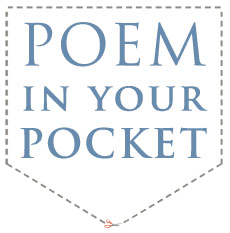Poem in Your Pocket Day 2013 is here!
Have you ever thought about why the National Poetry Month folks decided on “Poem in Your Pocket Day”? Poets came up with this day, so you already know there’s not going to be one straightforward answer — there are going to be layers of possible meaning. But I think it’s worth noting they could’ve picked another analogy for small or short — they could’ve made up “Bite-Size Poetry Day” or “Poem In Your Thimble Day” or “Poem That When Curled Up Into A Tiny Scroll Fits In Your Inner Ear Day.”
The poet’s ear elates at alliteration of course, but I think the “pocket” of “Poem in Your Pocket Day” is about more than that — these poets didn’t pick “Pint-Sized Poem Day” or “Post-It Poem Day” for instance.
They also didn’t pick “This Impossibly Long Poem Is Never Gonna End Day.”
So what is the relationship between the pocket and the poem? In modern day, the pocket is a clothing compartment universally known for storing words that we want to remember (as in notes to ourselves, to-do lists, passwords not to forget on the way back to our desks), as well as words that we intend to share (as in, taking your notecards out of your pocket as you walk up to the podium to deliver your speech). These two acts — remembering and sharing — are at the heart of what Poem in Your Pocket Day aims for, remembering and sharing poems. I would argue the pocket evokes the compact, square-but-not-quite-square form of the stanza — the original poetic building block, going back to before humans even wrote down our words, back when we just memorized our stories in order to tell them to each other again, and so invented rhyme and meter to make our stories easier to remember. The stanza is a pocket. The pocket is a stanza. The pocket is an envelope. A mouth. Your pocket (even more than a pocket or the pocket) is most often made of cloth, weaving in a long-standing analogy between fabric and language, that fine line between cloth and paper. And perhaps most importantly, your pocket is frequently associated with a location close to your heart.
For me, “pocket poems” are the poems short enough not to intimidate the poetry-wary — the friendly, the highly sharable poems. “Pocket poems” are poems that we keep in our heads — poems short enough to memorize, thereby reenacting on a small scale the very invention of poetry. And “pocket poems” are also the poems (of any length) that we keep close to our hearts — that we may “pull out,” as if from a pocket, on any given day, any hour, because they help us construct meaning from that given moment in your lives. The best, the most pocket-y-est of “pocket poems,” are all of those at once.
Today your friend Ellen and various other poetry enthusiasts scattered throughout the country will be handing out conveniently pocket-sized poems on the street to unsuspecting passers-by. Even when I’m feeling extra-introverted and not-so-courageous, or super-overworked-busy, I have never been sorry to have taken a couple of hours one day a year to hand poems to strangers. It is a truly rewarding experience — just try it; you’ll know soon enough what I mean. If you think this April might be your April to try it, here’s a PDF of pocket-sized poems for printing out, cutting out, and handing out. The Academy of American Poets — the folks who officially bring you National Poetry Month — also have a collection of pocket poems here. Some other suggestions for you from the Academy:
- Add a poem to your email footer for the day
- Post a poem on your blog or social networking page
- Text a poem to friends
- Start a street team to pass out poems in your community
- Post pocket-sized verses in public places
- Project a poem on a wall, inside or out
- Urge local businesses to offer discounts for those carrying poems
- Start a “poems for pockets” swap or give-a-way in your school or workplace
And, don’t forget: If today is not your day, no one knows when “real” Poem in Your Pocket Day is anyway — so take some poetic license! You’re pretty much good through the end of April / National Poetry Month. Or whenever.
Enjoy.
Ellen
The Shirt
The shirt touches his neck
and smoothes over his back.
It slides down his sides.
It even goes down below his belt—
down into his pants.
Lucky shirt.
Pocket-sized “The Shirt” by Jane Kenyon was also featured for Poem-a-Day April 7, 2009 and Poem-a-Day April 22, 2007.
